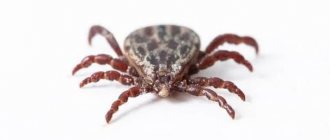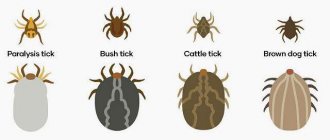Many people think that ticks can only bite a person or a dog, without posing a danger to the cat family. This is not true; according to statistics, cats suffer from tick bites and develop complications much less frequently, but the course of the disease, diagnosis and treatment are more difficult. Even domestic cats require special attention, since the parasite can enter the house through shoes or on human clothing.
Ticks are especially active from March to November; they can be found in grass or bushes, in city parks, and forests. Parasites pose a danger to walking animals, but even if the animal does not leave the house or apartment, the risk of finding a parasite in a cat is not so small.
What to do if your cat is bitten by a tick
If a cat is bitten by a tick, it is necessary to determine its type, of which there are more than 1000: dust ticks, ear ticks, scabies, etc. Ixodid ticks are considered the most dangerous for cats, as they are carriers of pathogens of many diseases.
It is necessary to examine the surface of the skin to determine the extent of its penetration. It is advisable if a specialist removes the parasite, since there is a risk of leaving part of the head under the skin. Also, when the insect moves strongly, the spread of infection increases.
Most often, bloodsuckers choose to bite the groin area, behind the hind legs, ears, stomach and armpit. An attached parasite is visible to the naked eye; immediately after detection, it is advisable to isolate the cat from children, take it to the veterinarian, or try to get rid of the insect yourself.
If a cat is bitten by a tick, then at this moment the animal does not experience pain or discomfort because upon penetration the parasite releases pain-relieving enzymes. Therefore, during the active months of parasite reproduction, you should regularly examine your cat; you can run a comb against the grain and feel the vulnerable spots.
Symptoms of a bite in cats
Symptoms of a tick bite in cats do not appear immediately after detection; the animal behaves calmly, has good appetite and sleep, and the cat does not feel pain, since the parasite uses pain-relieving enzymes during its introduction.
After it has been removed from the skin, it is necessary to monitor the condition of the pet. In case of infection and infection enters the bloodstream, the disease can begin to manifest itself only after a few weeks - the incubation period of infectious diseases.
Symptoms of a tick bite in a cat that should alert you:
- urine has turned pink;
- cough, heavy breathing;
- paleness of the nasal mucous membranes;
- vomiting, bowel dysfunction;
- signs of dehydration;
- sudden weight loss;
- loss of appetite or complete refusal;
- lethargy, lack of interest in the environment;
- heat.
If one or more symptoms occur, you should contact your veterinarian to preserve the health and life of your pet.
What does a tick look like and how does it “hunt”?
Externally, the tick looks like a spider with an oval body measuring 2.5 - 4 mm and eight limbs. On the small head there is a proboscis with sharp teeth, with which the parasite pierces the skin to get to the blood vessel. When bitten, saliva containing painkillers and blood thinners is injected into the victim's bloodstream. Having drunk blood, the parasite turns from a brown, almost flat creature into a red or brown ball.
Ticks are active from early spring to late autumn; they live in places with abundant vegetation: parks, forests, and lawns. Ticks, as a rule, are not able to climb higher than 1 meter, so he cannot jump from a tree. Having landed on the cat’s fur from the grass or bush, the tick “explores the territory” for some time to find the most convenient place to attach to the skin. Having chosen a suitable location, the tick gnaws through the dermis and attaches itself to the animal’s skin. It “disappears” only after its body is filled with the victim’s blood. The cat does not experience pain or itching, since the parasite releases anesthetic saliva into its blood.
Consequences of a bite
Are ticks dangerous for cats? The parasite's bite itself does not threaten the health of the pet; the danger lies in the pathogens that can get from it to the animal through the bite. The Ixodid tick can cause the development of diseases such as piroplasmosis, hemorrhagic fever, typhus and encephalitis, and borreliosis.
If treatment is not started on time, the infection can affect many body systems and internal organs of your furry friend.
If a cat is bitten by a tick, the consequences, symptoms and treatment depend on the type of infection. Some diseases only affect the cat’s immune system, it becomes lethargic and apathetic, but treatment in this case is 95% effective. Other diseases may not respond to treatment and lead to the death of the pet.
Preventive actions
Even after suffering from the disease, the body does not develop immunity to re-infection with subcutaneous mites. For this reason, it is important to carry out preventive measures in a timely manner. Experts give their recommendations on this matter.
They recommend:
- to exclude as much as possible possible contacts between the pet and other animals that may have health problems;
- regularly treat the cat’s skin using anti-inflammatory drugs;
- Monitor a balanced diet, vaccinations, and the amount of minerals and vitamins consumed in order to naturally maintain the cat’s high immunity.
Attentive attitude towards the animal becomes the key to its excellent health. A cat in excellent health is much less susceptible to subcutaneous mites, so she is safe.
What to do at home if you are bitten
If the bloodsucker has not burrowed into the pet’s skin and it is found on the fur or in the place where the cat sleeps, then it is necessary to inspect the skin. Using a comb, you need to comb the animal against the fur, push it apart with your hands and inspect the skin. Favorite places for parasites to invade are the armpits, hind legs, stomach and groin. If a bite is detected, it is necessary to treat the wound or take it to a veterinary hospital; you should monitor the cat’s health for several weeks; if deterioration occurs, you should consult a doctor.
You can get rid of the parasite as follows:
- Wear gloves on your hands, and upon completion of all manipulations, carefully perform hygiene.
- To prevent the infection from spreading faster, do not lubricate the area around the tick with oil.
- You should not pull the parasite, this will lead to further penetration of the insect's head and the spread of infection.
- The tick must be removed completely without damaging it.
- You can remove the insect using thread or tweezers. You should grab the body of the parasite and pull it out gently and without sudden movements.
- If, however, part of the tick’s head remains in the skin, there is no need to worry too much, since the cat’s body can independently reject the remaining body. This often leads to the development of a small abscess, which can be prevented by contacting a veterinarian.
Treatment is prescribed only by a veterinarian based on the test results and existing symptoms; usually, antibiotic therapy cannot be avoided. You are allowed to treat the bite site yourself at home using antiseptic drugs, with the exception of iodine and brilliant green.
Ixodid ticks in cats
A tick bite that carries piroplasmosis or encephalitis does not pose a danger to a cat, but other more dangerous diseases can develop, such as theileriosis, tularemia and hemobartonellosis. Ixodid ticks are one of the most famous types of parasites, common in many climatic zones.
Symptoms and consequences have different characteristics - it all depends on the type of pathogen. Each disease has a distinctive clinical picture and incubation period:
- Hemobartonellosis. This infectious disease causes anemia only in cats; the disease is not dangerous for humans and dogs. The infection, spreading throughout the body, settles in the lymph nodes, bone marrow, liver and spleen. The incubation period ranges from several days to three weeks. The manifestation of symptoms depends on the animal’s immune defense; with weak immunity, the disease becomes severe. The disease manifests itself in decreased appetite, rapid heartbeat, lethargy and fading of the cat, the skin is pale or yellow, and the temperature is elevated. Only an urgent visit to the veterinarian can save the life of a pet.
- Tularemia. The pathogen enters the lymph nodes through the cat’s blood, developing a purulent inflammatory process. After some time, the lesions are opened, which leads to even greater blood infection. The disease affects the spleen, liver and lungs. Tularemia manifests itself in the form of lethargy of the animal, the skin becomes yellowish, small ulcerations form on the mucous surfaces, the lymph nodes in the neck are enlarged, the animal experiences malaise and fever. If treatment is not started in time, the cat dies in a matter of time, one of the causes of death is necrosis of the tissues of the spleen, lungs and liver. This disease is dangerous to humans and is transmitted through contact.
- Theileriosis. The infection, entering the animal's blood, multiplies in the spleen, lungs, liver and lymph nodes, causing severe damage. The first symptoms appear 1–3 weeks after the tick bite: the cat becomes lethargic, the temperature rises, the skin is yellow, the cat looks thin and apathetic, and the appetite disappears. Upon examination, the veterinarian notes an increase in internal organs. The disease is difficult for cats to tolerate, and only timely treatment can save the animal’s life.
To prevent such consequences after an ixodid tick bite, it is necessary to carry out prevention, constant examination of the animal and timely treatment.
Symptoms of infection
If the dog owner has a picture of the disease and is familiar with the symptoms that characterize it, then emergency treatment can be started on time.
Symptoms may include:
- The earliest signs that should alert the owner are lethargy, a significant decrease in activity, loss of the dog’s inherent playfulness, failure to show joy, apathy, lack of desire to go for a walk, etc.;
- Lack of appetite, the dog only drinks, refusing even previously loved treats. Feeding the dog becomes a problem.
This is one of the main signs in the first days of infection; - Subsequently, on the third to fifth day, digestive symptoms become more alarming and obvious - vomiting appears, sometimes with mucus. At the same time, the dog has remained hungry for several days. Diarrhea is possible, the liquid masses of which have a bright yellow or greenish color. Symptoms of diarrhea are not necessary, but the color of the stool definitely changes;
- Stiffness of movement, reluctance to move, shortness of breath, as if every movement brings suffering. The dog tries to find a secluded place and not leave it. Such symptoms already indicate a progressive disease;
- The color of urine is a sign that necessarily accompanies the disease. The urine is much darker
, takes on the color of coffee or dark beer, sometimes even a dark brown color. Pyroplasmas in the blood destroy red blood cells, due to which the color of urine changes. This sign indicates irreversible processes that can lead to death; - Healthy dogs can tolerate the disease almost asymptomatically - the dog dies completely suddenly for its owners, without previously showing any special signs of illness. But the color of urine even in this case is unnatural, which owners should pay attention to;
- Fever;
- The mucous membranes of the eyes turn white.
Can a tick fall off on its own from a cat?
Ticks and cats are a hot topic for the hot season, since it is in the summer that animals most often suffer from parasite bites. Having discovered a parasite attached to a pet, many people have a question: can the tick fall off on its own?
It is better not to wait until it detaches itself; it is necessary to remove the insect as soon as possible, since the longer the parasite is under the skin, the more infection will enter the blood. In some cases, when the tick is completely saturated with blood, it is able to fall off on its own.
Can a cat die from a tick bite?
Are ticks dangerous for cats? The parasite itself does not pose a danger to the animal if it is not the causative agent of any disease.
Can a cat die from a tick bite? With timely treatment and treatment, the animal’s health is restored without complications. If urgent measures are not taken, the animal’s body weakens in a matter of time, exhaustion and disruption of the functioning of internal organs are observed, which leads to serious consequences, including death.
Prevention methods
Only by protecting your cat from ticks can you rest assured about its health..
Ticks do not bite cats when their fur and skin are treated with preparations with a contact, repellent effect. The death of the parasite occurs after a few minutes of being on the cat’s fur. The drugs are produced in the form of drops, collars, and sprays.
Effective means:
- Leopard;
- Hearts;
- Rolf Club;
- Bolfo;
- Frontline;
- Dana ultra;
- Beafar.
Anti-tick medications do not provide 100% confidence that arthropods will not attack your cat. But even if they cling to the wool, they will most likely fall off or die.
Are ticks on a cat dangerous for humans?
If it has already been saturated with cat blood, then it poses no danger to the human body. It is worth remembering that the parasite cannot infect a cat with encephalitis, while this disease is very dangerous for humans.
Having discovered a tick on an animal, it is possible that there may be several such parasites on the pet, in which case there is a risk that the insect will move onto a person’s skin and bite him. Therefore, it is important to examine your pet for parasites while wearing protective gloves.
Prevention of diseases transmitted by ticks
Unfortunately, there are no reliable vaccines to protect cats from tick-borne infections. Therefore, the only way to take care of your pet’s health is to strictly follow the requirements for infection prevention.
After each walk in the fresh air, carefully inspect the cat and comb it, paying special attention to the favorite places for ticks to attach.
To prevent tick attacks, special protective equipment should be used. Thus, drops with a repellent effect “Four with a tail” contain a mixture of essential oils that repel ticks and insects. “Bars” drops have an insectoacaricidal effect that destroys parasites, and “Bars” collars can protect a cat from ticks for up to 4 months.











